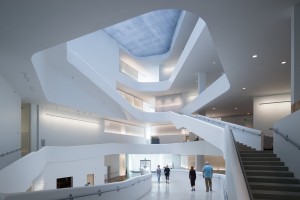Link to article here
“Being in bigger interactive spaces encourages expansive thinking, while being in a box of a room encourages box thinking,” said Dan Huttenlocher, founding dean and vice provost at Cornell Tech. “Sometimes you need to be in a box to concentrate, but to always sit in a little box is a problem.”
This sort of seems like a false analogy to me, or at least one that needs evidence to be convincing. It’s hard for me to just take Huttenlocher’s word that big rooms are better than small rooms for thinking, since I’m generally pretty okay with my “box” of a dorm room when I do homework.
“One thing about the building is it has no formal classrooms, and no faculty or staff offices,” said Troy D’Ambrosio, executive director of the institute. “We didn’t want to have a classroom because that says, ‘In this room you learn, out here you don’t learn.’”
I guess I never really thought about the psychological aspect of having classrooms that are separate from the rest of the building – I always figured it was just practical, but it does kinda seem like you’re supposed to learn in the classroom and outside of the classroom it’s just an option.
Dean Janusz Kozinski speaks of trying to create “Renaissance engineers,” in the manner of Leonardo da Vinci, and has set the ambitious goal of a student body that is 50 percent female. They have a long way to go. Currently, 17 percent of undergraduates are women.
17 percent seems like a pretty astoundingly low number. According to the Census Bureau’s 2009 American Community Survey (ACS), “women comprise 48 per- cent of the U.S. workforce but just 24 percent of STEM workers“(link). I guess we’ll have to wait and see what the statistics look like in about ten years.
Larger, purpose-built labs are equipped with professional-grade equipment for testing and prototyping, including a concrete-lined mechanical lab with a 12-ton crane. “This is where you get to build things like solar cars, or crush concrete,” [Paul Stevens] said.
That sounds pretty rad.

The new Visual Arts Building at the University of Iowa is designed to open up access and views to all art-making activities, and serves as a pathway through which the campus circulates. Credit Iwan Baan
All the non 90-degree angles are super cool, if not just a little bit uncomfortable to look at. My favorite thing about this picture is probably that light blue denim-looking ceiling, other than that it’s mostly just white and grey; I feel like buildings such as this one would inspire more “creativity” if they were brightly colored, but maybe that’s just me.